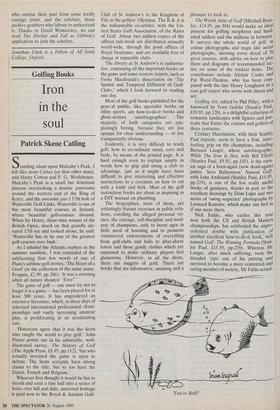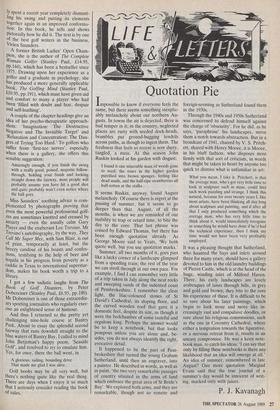Golfing Books
Iron in the soul
Patrick Skene Catling
Standing silent upon Mulcahy's Peak, I felt like stout Cortez (or that other man), and Henry Cotton and P. G. Wodehouse. Mulcahy's Peak is a small but dominant plateau overlooking a marine panorama around the western end of the Ring of Kerry, and the awesome par-3 17th hole of Waterville Golf-Links. Waterville is one of the most beautiful courses in Ireland, where beautiful golf-courses abound. When Sir Henry, three-time winner of the British Open, stood on that grandly ele- vated 17th tee and looked about, he said: 'Waterville has to be one of the greatest golf-courses ever built.'
As I inhaled the Atlantic zephyrs in the summer sunshine, I was reminded of the exhilarating first few words of one of Plum's sublime golf stories, 'The Heart of a Goof (in the collection of the same name, Penguin, £2.99, pp.206): it was a morning when all nature shouted "Forel" ' The game of golf — one must try not to forget it is a game — has been played for at least 500 years. It has engendered an extensive literature, which, in these days of televised international professional cham- pionships and vastly increasing amateur play, is proliferating at an accelerating rate.
'Historians agree that it was the Scots who taught the world to play golf,' John Pinner points out in his admirable, well- illustrated survey, The History of Golf (The Apple Press, £8.95, pp.112), 'but who actually invented the game is open to debate. The Scots certainly have strong claims to the title, but so too have the Dutch, French and Belgians.'
Whoever first thought it would be fun to thrash and coax a tiny ball into a series of holes over hill and dale, universal homage is paid now to the Royal & Ancient Golf- Club of St Andrew's in the Kingdom of Fife as the golfers' Olympus. The R & A is the indisputable co-arbiter, with the Un- ited States Golf Association, of the Rules of Golf. About two million copies of the official rule-book are distributed annually world-wide, through the good offices of Royal Insurance, and are available free of charge at reputable clubs.
The library at St Andrew's is authorita- tive, containing all the important books on the game and some esoteric papers, such as Fiona Macdonald's dissertation on 'The Spatial and Temporal Diffusion of Golf- Clubi,' which I look forward to reading one day.
Most of the golf books published for the gene,a1 public, like specialist books on other sports, are how-to-do-it books and ghost-written 'autobiographies'. The majority of both categories are eye- glazingly boring, because they are too opaque for clear understanding — or too transparently obvious.
Evidently, it is very difficult to teach golf, how to co-ordinate mind, eyes and body, by means of the printed page. It is hard enough even to explain simply in words how to grip and swing a club to advantage, just as it might have been difficult to give interesting and effective instructions to a caveman on how to eat with a knife and fork. Most of the golf instruction books are about as inspiring as a DIY manual on plumbing.
The biographies, most of them, are irritatingly blatant exercises in public rela- tions, extolling the alleged personal vir- tues, the courage, self-discipline and mod- esty of champions, only to boost egos in little need of boosting and to promote commercial endorsements of everything from golf-clubs and balls to after-shave lotion and those gaudy clothes which are supposed to make ordinary players feel glamorous. However, in all the dross, there are nuggets of gold. There are books that are informative, amusing and a pleasure to look at.
The World Atlas of Golf (Mitchell Beaz- ley, £14.95, pp.304) would make an ideal present for golfing neophytes and hard- ened addicts and the millions in between. It surveys the whole world of golf, .in colour photographs and maps like aerial photographs, showing every detail of 70 great courses, with advice on how to play them and diagrams of recommended tac- tics on some of the trickier holes. The contributors include Alistair Cooke and Pat Ward-Thomas, who has been com- pared with the late Henry Longhurst as a rare golf expert who wrote with charm and wit.
Golfing Art, edited by Phil Pilley, with a foreword by Tony Jacklin (Stanley Paul, £19.95, pp.128), is a delightful collection of romantic landscapes with figures and por- traits that flatter the courses and golfers of three centuries.
Century Hutchinson, with their Stanley Paul imprint, seem to have a firm, inter- locking grip on the champions, including Bernard Langer, whose autobiography, While The Iron Is Hot, with Bill Elliott (Stanley Paul, £9.95, pp.145), is the earn- est saga of a born-again (now dead-again) putter. Seve Ballesteros' Natural Golf, with John Andrisani (Stanley Paul, £14.95, pp.219), is one of the few really useful books of guidance, thanks in part to the excellent drawings by Dom Lupo and two series of 'swing sequence' photographs t'Y Leonard Kamsler, which make one feel as if one were there.
Nick Faldo, who earlier this year won both the US and British Masters championships, has celebrated the unpre- cedented double with publication of another excellent how-to-do-it book, well named Golf: The Winning Formula (Stan- ley Paul, £15.95, pp.239). Whereas Mr Langer, after much suffering, took the dreaded 'yips' out of his putting and survived to become a more contented and caring member of society, Mr Faldo actual-
'You're Brill!'
1)1 spent a recent year completely dismant- ling his swing and putting its elements together again in an improved conforma- tion. In this book, he tells and shows Pictorially how he did it. The text is by one of the best golf writers in the business, Vivien Saunders.
A former British Ladies' Open Cham- pion, she is the author of The Complete Woman Golfer (Stanley Paul, £14.95, Pp.144), which has been a bestseller since 1975. Drawing upon her experience as a golfer and a graduate in psychology, she has produced a more generally applicable book, The Golfing Mind (Stanley Paul, £10.95, pp.191), which must have given aid and comfort to many a player who had been 'filled with doubt and fear, despair and self-loathing'.
A couple of the chapter headings give an idea of her psycho-therapeutic approach- shots: 'Imagination: The Destructive Negative and The Invisible Target' and `Relaxation and Concentration: The Dan- gers of Trying Too Hard.' To golfers who suffer from 'first-tee nerves', especially when there is a gallery, she offers this sensible suggestion:
Amazingly enough, if you finish the swing with a really good, poised, majestic follow- through, holding your finish and looking straight down the fairway, most people will probably assume you have hit a good shot and quite probably won't even notice where the ball goes.
Miss Saunders' soothing advice is corn- Plemented by photographs proving that even the most powerful professional golf- ers are sometimes knotted and creased by anxiety — even the usually calm Gary Player and the exuberant Lee Trevino. Mr Trevino's autobiography, by the way, They Call Me Super Mex, with Sam Blair, is out of print, temporarily at least, but the breezy candour of his boasts and confes- sions, testifying to the help of beer and tequila in his progress from poverty as a caddie in Texas to international superstar- dom, makes his book worth a trip to a library.
I got a few sadistic laughs from The Book of Golf Disasters, by Peter Dobereiner (Stanley Paul, £6.95, pp.180). Mr Dobereiner is one of those extraordin- ary sporting journalists who regularly exer- cise an enlightened sense of humour.
And thus I returned to the pretty yet Challenging nine-hole course at Bantry Park. About to essay the splendid second fairway that runs downhill straight to the blue waters of Bantry Bay, I called to mind John Betjeman's happy poem, 'Seaside Golf', and resolved to try to emulate him. Yes, for once, there the ball went, in
A glorious, sailing, bounding drive That made me glad I was alive.
Golf books may be all very well, but there's nothing quite like the real thing. There are days when I enjoy it so much that I seriously consider reading the book of rules.











































 Previous page
Previous page